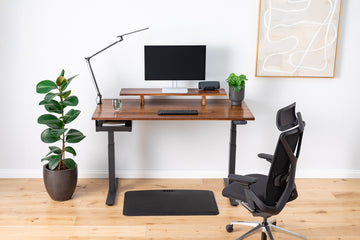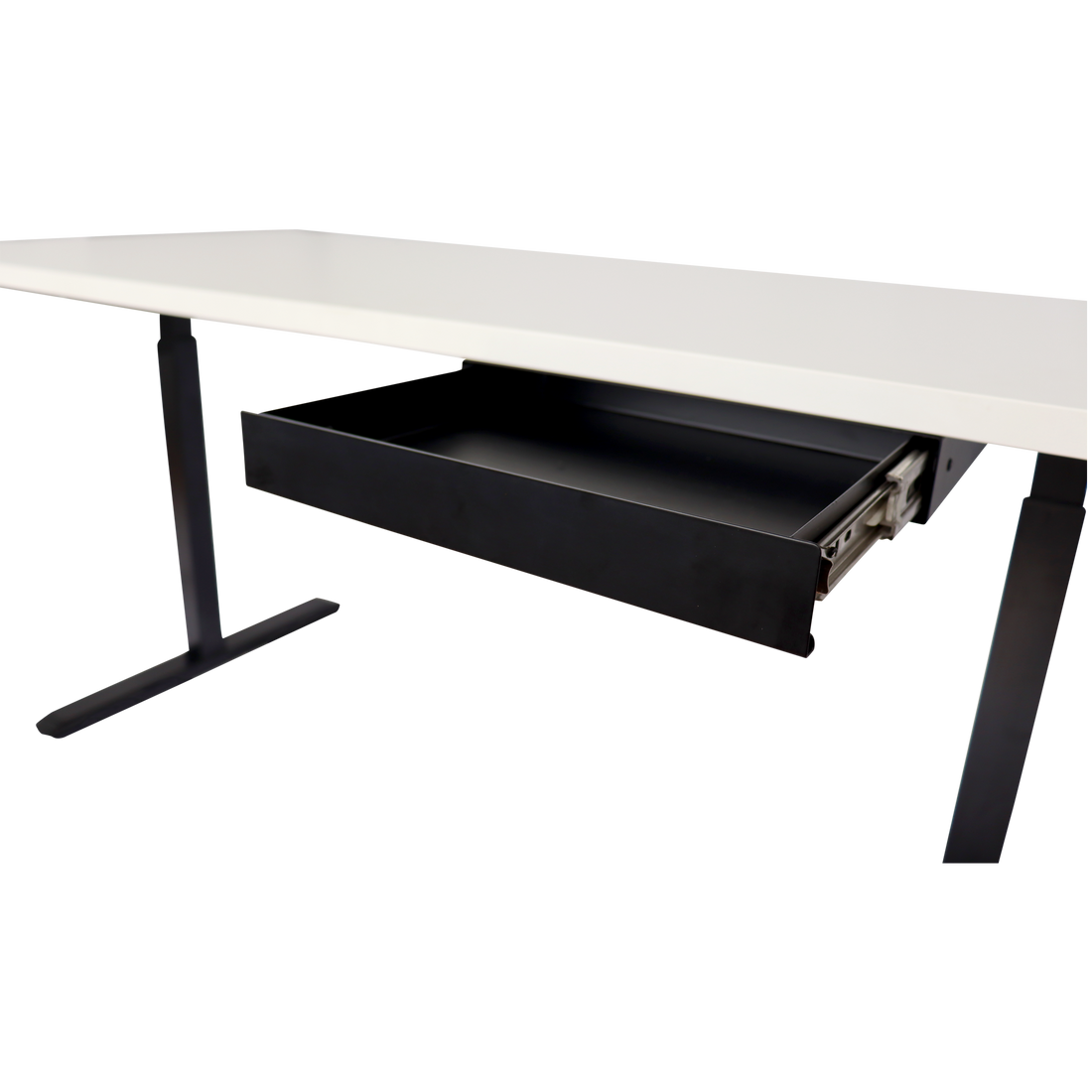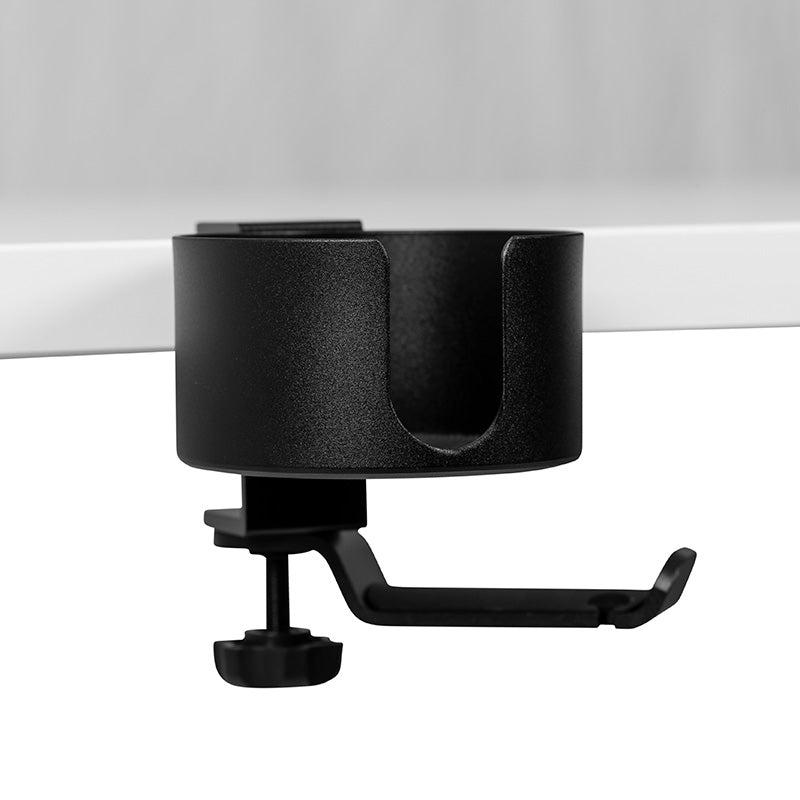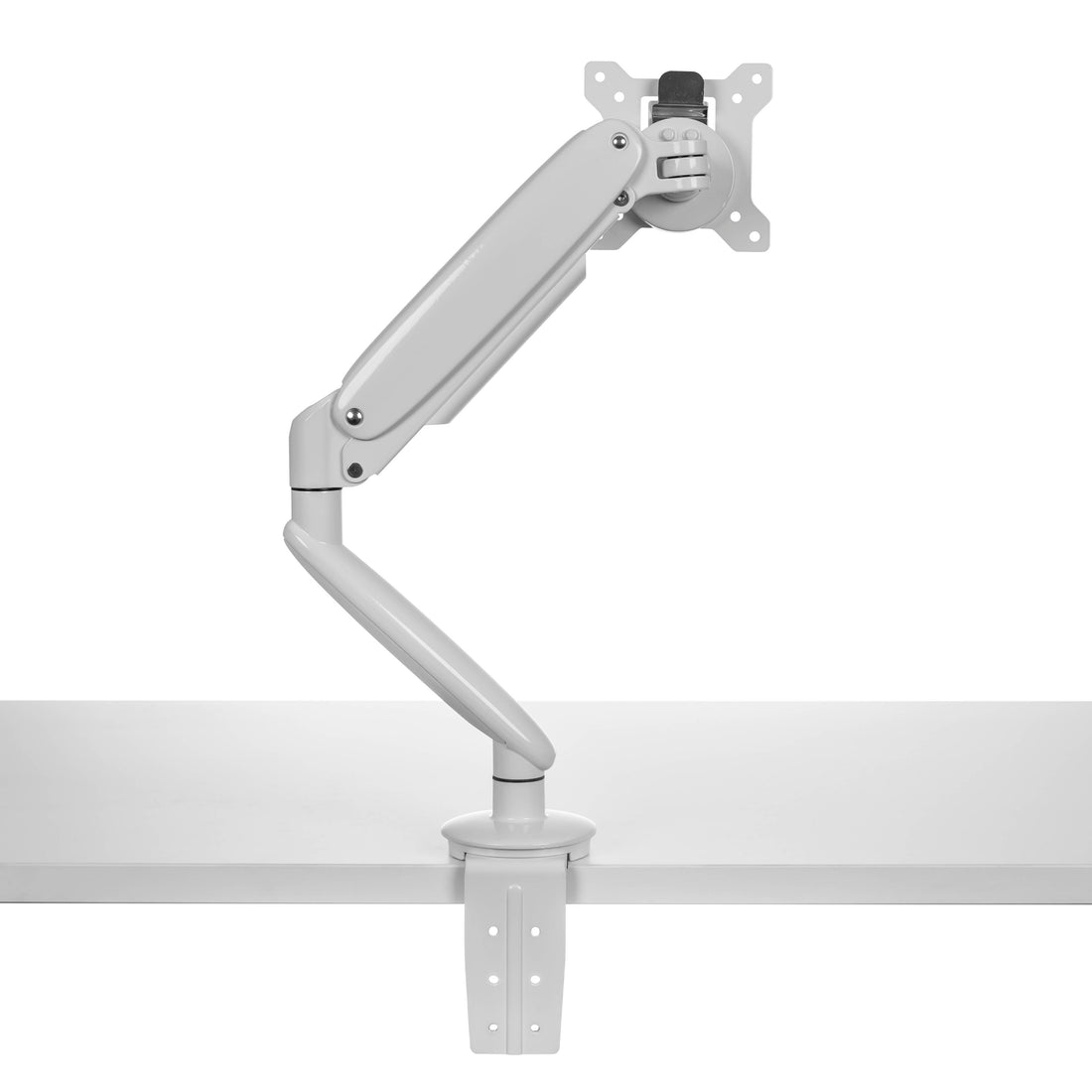
Getting the right standing desk height is vital to staying comfortable and productive in today’s dynamic work environment. As more people discover the perks of standing desks, it’s essential to know how to set them up properly.
This guide covers everything from user height and monitor height to keyboard position, helping you keep a neutral body posture. The right desk height can ease muscle and joint strain and lower the risk of musculoskeletal problems, boosting your overall well-being and work performance.
Whether you’re just starting with a standing desk or want to fine-tune your current setup, this guide offers the insights you need for a healthier, more efficient workspace. Learn how to customize your standing desk to fit your needs and enhance your workday.
How to Determine the Ideal Standing Desk Height
Finding the perfect standing desk height involves considering several factors to create an ergonomic work station:
- User Height
- Monitor Height
- Keyboard Position
The goal is to maintain a neutral body posture, which minimizes strain on your muscles and joints. Achieving this balance can significantly reduce the risk of musculoskeletal disorders, enhance comfort, and boost productivity.
User Height
The primary determinant of ergonomic desk height is the user's height. A desk set at the wrong height can lead to awkward postures, which may cause strain and discomfort over time. By aligning the desk height with your own, you ensure your body maintains a neutral posture.
Monitor Height
Ensure that the top of the screen is at or slightly below eye level. This helps prevent neck strain by allowing you to keep your head and neck in a neutral position. Staring down at a monitor that is too low or craning your neck upward can lead to discomfort and long-term issues. Adjusting the monitor height is a simple yet effective way to enhance overall comfort and productivity.
Keyboard Position
Keep your wrists straight and elbows at approximately a 90-degree angle. This is crucial for preventing strain in your arms and wrists. An incorrectly positioned keyboard can lead to repetitive strain injuries, such as carpal tunnel syndrome. Ensuring your keyboard is positioned correctly can help maintain a comfortable and efficient work environment.
Calculate the Correct Desk Height
To find the ideal standing desk height, ensure elbows rest at approximately a 90-degree angle when typing or using a mouse. Here's a simple step-by-step guide to measure this:
- Stand up straight with shoulders relaxed.
- Bend elbows at approximately a 90-degree angle.
- Measure the distance from the floor to the bottom of the hands.
- Adjust the desk height to match this measurement.
 Correct standing desk height - between 90 - 100 degrees. Note that in this photo I am at about 100 degrees, which I find more comfortable for me personally.
Correct standing desk height - between 90 - 100 degrees. Note that in this photo I am at about 100 degrees, which I find more comfortable for me personally.

Standing Desk Height Chart
The standing desk height chart is crucial for users looking to enhance their workplace ergonomics. It tackles a common question: how tall should a standing desk be? Matching the desk height to one's physical dimensions ensures that the workspace is comfortable, promotes better posture, and reduces the risk of strain.
The chart below provides suggested desk heights based on user height measurements. These guidelines help users set up their standing desks to promote optimal alignment and usability.
| User's Height (feet and inches) | Desk Height (centimeters / inches) |
| 5'0" | 96.5cm / 38in |
| 5'2" | 99.1cm / 39in |
| 5'4" | 101.6cm / 40in |
| 5'6" | 104.1cm / 41in |
| 5'8" | 106.7cm / 42in |
| 5'10" | 109.2cm / 43in |
| 6'0" | 111.8cm / 44in |
| 6'2" | 114.3cm / 45in |
| 6'4" | 116.8cm / 46in |
Tailoring to Individual Needs
Tailoring standing desk height is about more than just following a chart. People should make adjustments if they wear high heels, for example. Additionally, accessories like desk risers or adjustable monitor stands can aid in achieving the absolute personal ergonomic setting.
For instance, a user who is 5'6" tall finds the ideal standing desk height at 41 inches. This height sets the stage for an ergonomic workspace, aligning the monitor at eye level and the forearms comfortably parallel to the ground.
Consider a taller individual, say 6'4", who would adjust their desk to 46 inches. This personalized adjustment ensures the desk adequately accommodates their height, minimizing hunching or excessive reaching, which can lead to discomfort and reduced effectiveness. Standing desks for tall people provide the necessary flexibility to achieve proper ergonomics, promoting comfort and productivity.
Why Standing Desk Height Matters
Beyond just optimizing the height of your standing desk for comfort, there are significant health and productivity benefits. Here are some key benefits to know:
- Reducing back and neck pain: Proper alignment of the spine and neck minimizes strain, helping to prevent chronic pain and discomfort. Maintaining a neutral posture can also reduce the risk of developing conditions such as herniated discs and sciatica.
- Improving circulation: Encourages blood flow and reduces fatigue by promoting movement and preventing prolonged static postures. Better circulation helps deliver oxygen and nutrients to your muscles, reduce fatigue risk, and improve overall energy levels.
- Enhancing focus and energy levels: A comfortable posture helps maintain concentration and reduces fatigue risk, leading to higher productivity and better work quality. Being comfortable at your standing desk allows you to focus on your tasks without being distracted by discomfort or pain.
Adjusting Your Desk Height for Different Tasks
Different tasks may require slight ergonomic standing desk height adjustments to maintain optimal comfort. Here are some specific activities to consider:
- Typing
- Writing
- Using Multiple Monitors
Customizing your ergonomic desk height for these specific activities can ensure greater comfort and efficiency. This flexibility in desk height can help you transition smoothly between various tasks, reducing strain and improving overall productivity.
Typing
- Keyboard: Should be at elbow height with wrists straight. This position helps prevent strain in the wrists and forearms, reducing the risk of repetitive strain injuries.
- Positioning: Keep your shoulders relaxed and elbows at approximately a 90-degree angle. This helps maintain a neutral posture, preventing shoulder and upper back tension. Maintaining this posture can help prevent the onset of fatigue and discomfort during extended periods of typing.
Writing
- Surface: The desk should be slightly lower than the typing height for comfortable handwriting. This allows your hand to rest naturally on the desk, reducing strain and improving handwriting quality. A lower desk height also helps maintain a comfortable wrist position, preventing strain.
- Posture: Maintain a straight back and avoid leaning forward excessively. Keeping a neutral spine helps prevent back pain and promotes better overall posture.
Using Multiple Monitors
- Alignment: Ensure both monitors are at eye level and aligned horizontally. This setup helps prevent neck strain and promotes better focus by reducing the need for head movement. Proper monitor alignment can also help maintain a consistent viewing angle, reducing the risk of strain.
- Adjustment: Position monitors close enough to avoid excessive head movement. Keeping the monitors within a comfortable viewing distance reduces eye strain and helps maintain concentration. Regularly adjusting the monitor position based on comfort can help prevent strain and improve productivity.
Below is a table providing suggestions for desk heights for various tasks based on the user's height:
| User's Height (ft, in) | Typing Height (cm/in) | Writing Height (cm/in) | Multiple Monitors Height (cm/in) |
| 5'0" | 57.2cm / 22.5in | 52.1cm / 20.5in | 62.2cm / 24.5in |
| 5'4" | 60.7cm / 23.9in | 55.9cm / 22in | 64.8cm / 25.5in |
| 5'8" | 64.8cm / 25.5in | 59.7cm / 23.5in | 68.6cm / 27in |
| 5'10" | 69.3cm / 27.3in | 66.0cm / 26in | 72.4cm / 28.5in |
| 6'0" | 71.1cm / 28in | 68.1cm / 26.8in | 74.4cm / 29.3in |
| 6'2" | 73.2cm / 28.8in | 69.9cm / 27.5in | 76.2cm / 30in |
| 6'4" | 75.7cm / 29.8in | 72.4cm / 28.5in | 78.7m / 31in |
Desk Height and Corresponding Equipment Considerations
Proper equipment setup is essential for maintaining ergonomic practices at your standing desk. Ensuring your monitors, keyboard, and other equipment are correctly positioned can help maintain a comfortable and productive work environment. A well-organized desk setup can enhance efficiency and reduce the risk of strain-related injuries associated with bad desk ergonomics.
Monitor Positioning
The top of the monitor should be at or just below eye level to help maintain a neutral neck position, reducing the risk of strain and discomfort. Modifying the monitor height is essential for avoiding neck pain and ensuring a comfortable viewing angle. Placing the monitor at arm's length helps reduce eye strain by allowing for comfortable viewing without excessive eye movement or strain. Frequently assessing and changing the monitor distance can help prevent eye strain and enhance overall comfort.

Dual Monitor Setup Tips
Proper alignment and usage are key to maintaining comfort and productivity when setting up a dual-monitor workspace. Both monitors should be at the same height to ensure a consistent viewing angle and prevent neck strain from looking up or down at different screens. Position the primary monitor directly in front of you and the secondary monitor to the side, allowing easy access to both screens without causing excessive head movement. Consistently adjusting the monitor positions based on your tasks can help maintain a comfortable and efficient workspace.
Keyboard and Mouse Placement
Keeping both devices on the same surface helps maintain a neutral wrist position, reducing the risk of strain and discomfort and helping prevent repetitive strain injuries. Ensuring the keyboard and mouse are at elbow height promotes a comfortable typing posture and prevents strain on the wrists and forearms.
Importance of Alternating Between Sitting and Standing
Alternating between sitting and standing is crucial for maintaining comfort and reducing fatigue. Regularly switching positions throughout the day helps prevent the harmful effects of prolonged static postures, improves circulation, and reduces fatigue risk. Knowing how long to stay at a standing desk is also essential to maximize these benefits. A sit-stand desk converter can simplify this process, promoting a more dynamic and comfortable work environment. Frequent use of such a device can help prevent the onset of strain and fatigue, making it easier to maintain a healthier and more productive work routine.
Maintaining Ergonomic Practices
Maintaining consistent ergonomic habits is essential for long-term health benefits. Here are key aspects to focus on:
- Regular Breaks and Movement
- Stretching Exercises
- Monitoring and Adjusting Your Setup Regularly
Periodically checking and adjusting your desk setup based on your ergonomic needs can help prevent the onset of strain and fatigue.
Regular Breaks and Movement
Regular breaks and incorporating movement into your routine are essential for maintaining focus and preventing fatigue. Aim to take short breaks every 30 minutes to allow your body to recover from prolonged static postures. Regular movement helps improve circulation and reduce the risk of strain.
Stretching Exercises
Stretching exercises are essential for reducing tension and preventing discomfort. Simple neck stretches can help relieve muscle tightness from prolonged screen time and avoid the onset of strain and fatigue. Consistently performing neck stretches can significantly improve your overall comfort. Leg stretches, on the other hand, help prevent stiffness from standing and improve circulation, reducing the risk of muscle discomfort. By regularly incorporating leg stretches into your routine, you can maintain a comfortable and efficient workspace.
Monitoring and Adjusting Your Setup Regularly
Regularly monitoring and adjusting your setup is essential for maintaining comfort and ergonomics. Periodically checking and adjusting your desk height and equipment positioning helps ensure that your workspace meets your ergonomic needs, preventing the onset of strain and fatigue. Making small changes as needed based on feedback from your body can promote long-term comfort.
Ergonomic Office Chairs
Incorporating an ergonomic office chair alongside your standing desk is a perfect way to ensure well-being throughout your workday. These chairs are designed to provide optimal support for your back and spine, minimizing strain and discomfort, especially during extended sitting periods. Look for features like adjustable lumbar support, armrests, and headrests to find a chair that perfectly conforms to your body.
Expert Insights
Physiotherapist Jordan Lees' Tips
Jordan Lees, a physiotherapist, emphasizes maintaining a neutral posture and regular movement. His insights provide valuable guidance for setting up an ergonomic workspace. Lees suggests that the ideal desk height lets you keep your elbows at approximately a 90-degree angle and your wrists straight. He also recommends taking regular breaks and incorporating movement into your daily routine to prevent fatigue and promote overall health.
Lees highlights the importance of making minor adjustments to your desk setup based on your comfort and ergonomic needs. He emphasizes the need for regular movement to prevent the onset of strain and fatigue.
Common Mistakes and How to Avoid Them
It's easy to fall into bad habits when setting up a standing desk, but knowing common mistakes can help you maintain a healthier and more productive workspace. Here are some frequent issues and tips to avoid them:
- Incorrect height: Adjust your desk to the appropriate height to avoid strain. A desk that is too high or too low can cause discomfort and lead to musculoskeletal issues. Regularly checking and adjusting the desk height can help prevent the onset of strain and fatigue.
- Static posture: Avoid standing still for too long. Regular movement is key. Alternating between sitting and standing and taking short breaks can help prevent the negative effects of prolonged static postures. Incorporating movement and breaks into your routine can help maintain a comfortable and efficient workspace.
- Ignoring Footwear and Floor Support: Standing for extended periods requires proper footwear and adequate floor support. Avoid high heels or flat shoes without support, and consider using an anti-fatigue mat.
FAQ
How to Set Standing Desk Height?
Measure the distance from the floor to your elbows while standing to set your desk at the optimal ergonomic desk height. Ensure your monitor is at eye level and your keyboard and mouse are within easy reach to maintain a neutral posture.
How Tall Should a Standing Desk Be?
A standing desk should be at or slightly below elbow height when standing. This ensures comfortable use of the keyboard and monitor, maintaining proper body alignment and reducing the risk of musculoskeletal issues.
Can a Standing Desk be Too High or Too Low?
Yes, a desk that is too high or too low can cause strain and discomfort. A too-high desk makes you raise your shoulders, while a too-low desk causes hunching. Proper height adjustments prevent strain and fatigue.
How Often Should I Change the Height of My Standing Desk?
Adjust your desk height to suit different tasks and encourage movement. Lower it for typing and raise it for reading or drawing. Changing the height throughout the day reduces the risk of discomfort and improves comfort and efficiency.
Is Investing in a Standing Desk Worthwhile?
Investing in a standing desk is beneficial for those who work long hours at a desk. Properly adjusted desks enhance comfort, reduce strain, and promote better posture. Standing desk benefits include increased productivity and a more dynamic work environment.







